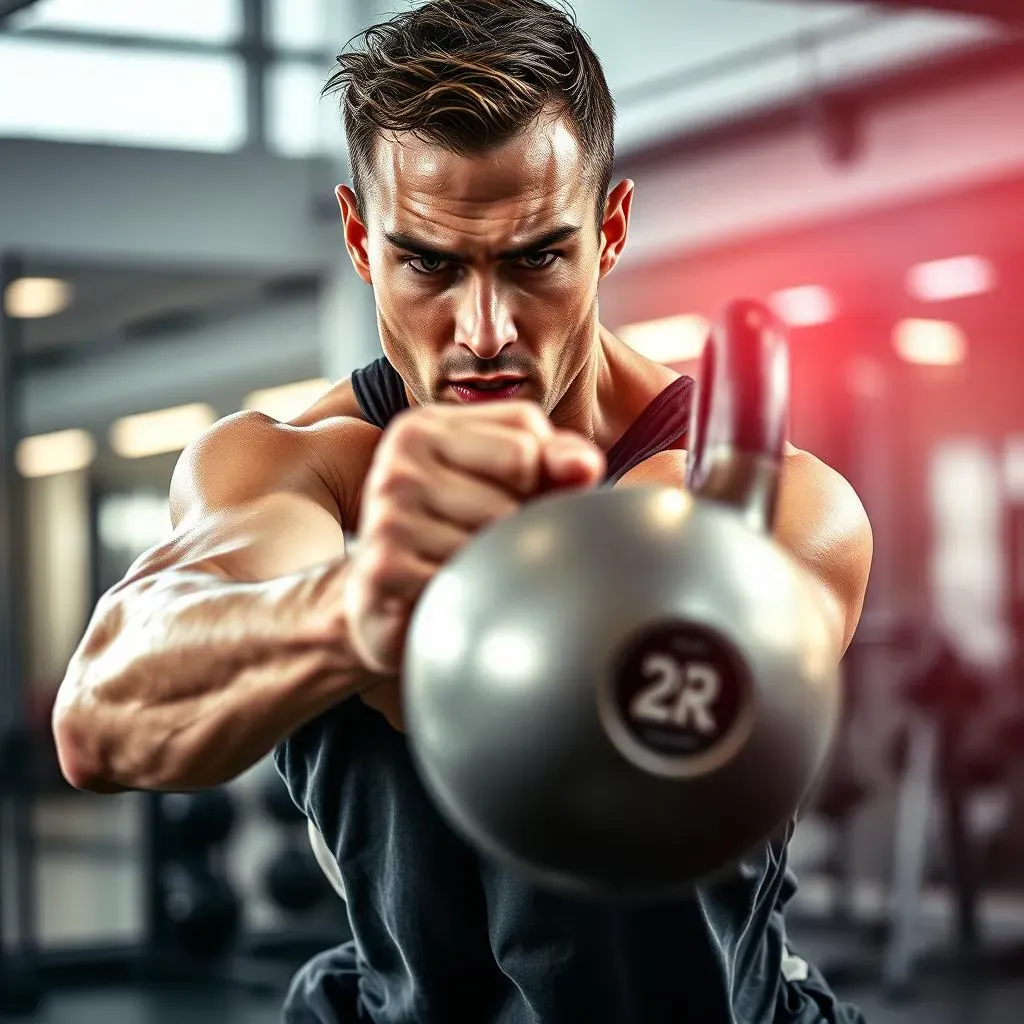Table of Contents
Ready to ditch the crowded gym and unlock a powerful, efficient way to transform your body? The answer might just be swinging right in front of you: kettlebells. Forget endless hours on the treadmill or isolating muscles with machines. The ultimate full body kettlebell workout delivers a dynamic, full-body challenge that torches calories, builds functional strength, and enhances your endurance, all in a single session. This isn't your average workout fad. Kettlebells have been a staple in strength training for centuries, and for good reason. They engage multiple muscle groups simultaneously, forcing your body to work as a cohesive unit. This article will guide you through the essential kettlebell exercises, providing a structured workout routine to help you achieve your fitness goals. We'll break down proper form, discuss how to scale the exercises to your current fitness level, and offer tips for maximizing results while minimizing the risk of injury. So, grab a kettlebell (or two!) and let's get started on your journey to a stronger, leaner, and more powerful you. Get ready to experience the transformative power of the ultimate full body kettlebell workout!
Unlocking FullBody Fitness: Why Kettlebells Are Your Ultimate Tool

Unlocking FullBody Fitness: Why Kettlebells Are Your Ultimate Tool
The Kettlebell Advantage: More Than Just a Weight
So, you're curious about kettlebells? Awesome! Let's be real, the fitness world is overflowing with gadgets and trends, but kettlebells have stood the test of time for a reason. They're not just another weight; they're a gateway to unlocking full-body fitness in a way that dumbbells and barbells often can't match. Think about it: the offset center of gravity in a kettlebell forces you to engage your core and stabilize your entire body with every movement. You're not just lifting; you're constantly fighting to control the weight, which translates to serious strength gains and improved balance.
What makes kettlebells so special? It's their unique design. The weight distribution challenges your body differently than dumbbells, activating more muscles with each swing, lift, or press. This leads to improved coordination, balance, and overall functional strength. Kettlebells aren't just about building muscle; they're about building a body that moves better and feels stronger in everyday life.
Beyond the Burn: The Holistic Benefits of Kettlebell Training
so we know kettlebells build strength, but the benefits go way beyond just bigger biceps. Kettlebell training is a fantastic way to improve your cardiovascular fitness. Those dynamic movements, like swings and snatches, get your heart pumping and your lungs working. Plus, because you're engaging so many muscle groups at once, you're burning a ton of calories in a relatively short amount of time. Talk about efficient!
But wait, there's more! Kettlebells are also amazing for improving your mobility and flexibility. The flowing movements help to loosen tight muscles and increase your range of motion. And let's not forget the mental benefits. There's something incredibly satisfying about mastering a challenging kettlebell exercise. It builds confidence and a sense of accomplishment that spills over into other areas of your life.
Kettlebells for Everyone: Debunking the Myths
One of the biggest misconceptions about kettlebells is that they're only for hardcore athletes or CrossFit fanatics. That's simply not true! Kettlebell training is scalable to all fitness levels. You can start with lighter weights and focus on mastering the fundamental movements before progressing to heavier weights or more complex exercises. The key is to listen to your body and gradually increase the challenge as you get stronger.
Don't be intimidated by the seemingly complex exercises. With proper instruction and a little practice, anyone can learn to safely and effectively use kettlebells. In fact, kettlebells can be a great way to introduce strength training to people who are new to fitness. They're fun, engaging, and offer a full-body workout in a fraction of the time compared to traditional weightlifting.
Are you ready to experience the transformative power of kettlebells?
The Ultimate Full Body Kettlebell Workout: Exercises and Technique

The Ultimate Full Body Kettlebell Workout: Exercises and Technique
Mastering the Fundamentals: The Swing and the Goblet Squat
Alright, let's dive into the heart of the ultimate full body kettlebell workout: the exercises themselves! We're going to start with two foundational movements that will build a solid base for everything else: the kettlebell swing and the goblet squat. The swing is like the king of kettlebell exercises – it's a powerhouse move that works your posterior chain (glutes, hamstrings, and back) while also engaging your core and shoulders. Think of it as a dynamic hip hinge, not a squat. The power comes from your hips, not your arms. Imagine you're hiking a football between your legs, exploding forward with each rep.
Now, let's talk about the goblet squat. This exercise is fantastic for building lower body strength and improving your squat mechanics. Hold the kettlebell close to your chest, like you're cradling a baby (hence the name "goblet"). As you squat down, focus on keeping your back straight, your chest up, and your elbows inside your knees. This will help you maintain proper form and engage your core throughout the movement. These two moves alone will give you a killer workout!
Unlocking Full-Body Power: Presses, Rows, and Lunges
now that we've got the swing and goblet squat down, let's add some more exercises to round out our full-body routine. Overhead presses are fantastic for building shoulder strength and stability, while also engaging your core. Start with the kettlebell in the racked position (resting on your forearm) and press it straight overhead, keeping your core tight and your wrist straight. If you're new to presses, start with a lighter weight and focus on mastering the form before going heavy.
Next up, we've got rows. Kettlebell rows are a great way to strengthen your back muscles and improve your posture. Hinge at your hips, keeping your back flat, and row the kettlebell towards your chest, squeezing your shoulder blades together. You can do these single-arm or double-arm, depending on your preference and the weight of the kettlebell. Finally, don't forget lunges! Kettlebell lunges are a fantastic way to work your quads, glutes, and hamstrings, while also improving your balance and coordination. Hold the kettlebell in the racked position or down by your side as you lunge forward, keeping your front knee behind your toes and your back knee close to the ground.
Crafting Your Kettlebell Routine: Sets, Reps, and Progression for Full Body Results

Crafting Your Kettlebell Routine: Sets, Reps, and Progression for Full Body Results
Finding Your Starting Point: Assessing Your Fitness Level
so you're ready to build your ultimate full body kettlebell workout routine. Before you jump in and start swinging heavy weights, it's crucial to take a step back and assess your current fitness level. This isn't about ego; it's about setting yourself up for success and avoiding injuries. Have you been consistently working out? Are you familiar with basic movements like squats, lunges, and push-ups? If you're a complete beginner, it's wise to start with bodyweight exercises or lighter dumbbells to build a foundation of strength and stability before introducing kettlebells.
Think of it like learning to play an instrument. You wouldn't pick up a guitar and immediately try to shred a solo, right? You'd start with basic chords and scales. The same principle applies to kettlebell training. Start with mastering the fundamental movements, like the swing and goblet squat, using a lighter weight. Focus on proper form and technique. As you get stronger and more comfortable, you can gradually increase the weight and complexity of the exercises. This approach will not only prevent injuries but also ensure that you're building a solid foundation for long-term progress.
Structuring Your Workout: Sets, Reps, and Rest
Alright, you've got your exercises picked out, and you know what weight you're going to use. Now, let's talk about structuring your workout. When it comes to sets, reps, and rest, there's no one-size-fits-all answer. It really depends on your goals. Are you looking to build strength? If so, you'll want to focus on lower reps (6-8) with heavier weights and longer rest periods (2-3 minutes). Are you trying to build endurance? Then, aim for higher reps (12-15) with lighter weights and shorter rest periods (30-60 seconds). For general fitness and muscle building, a good starting point is 3 sets of 8-12 reps with moderate weight and 60-90 seconds of rest between sets.
Consider using supersets. A superset involves performing two exercises back-to-back with minimal rest in between. For example, you could do a set of kettlebell swings followed immediately by a set of goblet squats. This is a great way to increase the intensity of your workout and burn more calories in less time. Just be sure to choose exercises that work different muscle groups to avoid overtaxing any one area. And remember, proper form is always more important than the number of reps you're doing. So, if you find that your form is breaking down, reduce the weight or the number of reps.
Goal | Sets | Reps | Rest |
|---|---|---|---|
Strength | 3-5 | 6-8 | 2-3 minutes |
Endurance | 2-3 | 12-15 | 30-60 seconds |
General Fitness | 3 | 8-12 | 60-90 seconds |
Progressive Overload: The Key to Long-Term Gains
The key to seeing continuous progress with your ultimate full body kettlebell workout is progressive overload. This simply means gradually increasing the demands you place on your body over time. There are several ways to do this. You can increase the weight you're lifting, the number of reps you're performing, or the number of sets you're doing. You can also decrease the rest time between sets or try more challenging variations of the exercises.
For example, if you've been doing 3 sets of 10 kettlebell swings with a 16kg kettlebell for a few weeks, and it's starting to feel easy, it's time to increase the challenge. You could either increase the weight to a 20kg kettlebell, increase the number of reps to 12, or add a fourth set. The important thing is to consistently challenge yourself and avoid plateauing. However, it's also important to listen to your body and avoid pushing yourself too hard, too soon. Gradual progression is the key to long-term success and injury prevention. A good rule of thumb is to increase the weight by no more than 5-10% at a time.
Beyond the Workout: Maximizing Results and Avoiding Injury with Your Kettlebell

Beyond the Workout: Maximizing Results and Avoiding Injury with Your Kettlebell
Fueling Your Body: Nutrition for Kettlebell Performance
So, you're crushing your ultimate full body kettlebell workout, but are you fueling your body properly? You can't expect to build muscle and burn fat on an empty tank. Nutrition is a crucial component of any fitness program, and kettlebell training is no exception. Focus on eating a balanced diet that includes plenty of protein, complex carbohydrates, and healthy fats. Protein is essential for muscle repair and growth, so aim to consume at least 0.8 grams of protein per pound of body weight per day. Complex carbohydrates provide your body with the energy it needs to power through your workouts, so load up on whole grains, fruits, and vegetables. And don't forget healthy fats, which are important for hormone production and overall health. Think avocados, nuts, and olive oil.
Don't underestimate the importance of hydration. Dehydration can lead to fatigue, muscle cramps, and decreased performance. Drink plenty of water throughout the day, especially before, during, and after your workouts. A good rule of thumb is to drink half your body weight in ounces of water per day. For example, if you weigh 150 pounds, aim to drink 75 ounces of water per day. You may also want to consider supplementing with electrolytes, especially if you're sweating a lot. Electrolytes help to regulate fluid balance and prevent muscle cramps.
Listening to Your Body: Rest, Recovery, and Injury Prevention
Pushing yourself is great, but knowing when to back off is even more important. Rest and recovery are just as crucial as the workouts themselves. Your muscles need time to repair and rebuild after a tough kettlebell session. Aim for at least 7-8 hours of sleep per night. Sleep deprivation can lead to increased stress hormones, decreased muscle growth, and increased risk of injury. Also, schedule rest days into your workout routine. Overtraining can lead to fatigue, burnout, and injuries. A good rule of thumb is to take at least one rest day per week.
Pay attention to your body and listen to any pain signals. Don't try to push through pain. If you're experiencing pain, stop the exercise and rest. If the pain persists, see a doctor or physical therapist. Preventative care is key. Be sure to warm up properly before each workout and cool down afterward. Dynamic stretching is a great way to warm up your muscles and prepare them for exercise. Static stretching is best done after your workout to improve flexibility and reduce muscle soreness. And don't forget to foam roll! Foam rolling can help to release muscle tension and improve blood flow.
Gear Up for Success: Kettlebell Selection and Proper Attire
Using the right gear can make a huge difference in your ultimate full body kettlebell workout experience. Start with the kettlebell itself. Choosing the right weight is crucial. If you're a beginner, start with a lighter weight and gradually increase it as you get stronger. For women, an 8kg or 12kg kettlebell is a good starting point. For men, a 12kg or 16kg kettlebell is a good starting point. It's better to start too light than too heavy. You can always increase the weight later. Also, consider the handle of the kettlebell. Make sure it's comfortable to grip and doesn't have any sharp edges.
Wear comfortable clothing that allows you to move freely. Avoid clothing that is too tight or restrictive. Athletic shoes with good support are essential. You'll be doing a lot of jumping and landing, so you need shoes that will protect your feet and ankles. Some people also like to wear gloves to protect their hands from blisters. Chalk can also help to improve your grip. And don't forget a towel to wipe away sweat! Kettlebell training can be a sweaty business.
Your Kettlebell Journey: Continuing the Full Body Transformation
The ultimate full body kettlebell workout isn't just a routine; it's a pathway to a stronger, more resilient you. By mastering the fundamental movements, progressively increasing the challenge, and prioritizing proper form, you'll unlock a world of fitness benefits. Remember, consistency is key. Incorporate kettlebell training into your regular fitness regime, listen to your body, and celebrate your progress. Whether you're aiming to build muscle, shed fat, or simply enhance your overall fitness, the kettlebell offers a versatile and effective tool for achieving your goals. So, keep swinging, keep pushing, and keep transforming!